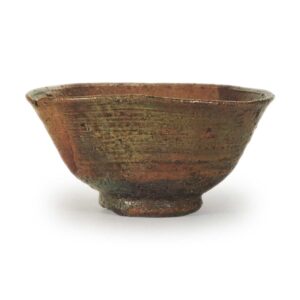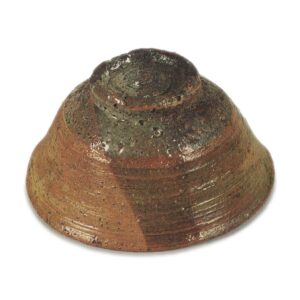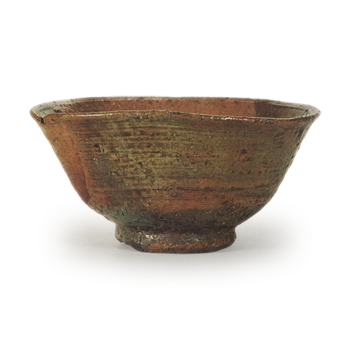

Collection: Fujita Museum of Art
Height: 7.2 – 7.5 cm
Diameter: 13.7 – 14.5 cm
Outer diameter of foot ring: 6.0 cm
Height of foot ring: 1.2 cm
The one-sided hand is very similar to the Chigusa-te, but both share the same basic style of Ko-Iroha.
In other words, the clay is the same, the mouth is decorated with incised lines and bevels, the interior is brushed, and the foot is shaped like a large bamboo joint, with the opening facing upwards. It is said that fragments of the katamigawari ware were found at the site of the Shoki kiln near Busan, and it is likely that other Irahos and Chigusa-te were also fired here.
There does not seem to be a satisfactory theory about the origin of the name “irabo” yet, but in the Genroku period text “Michisa”, the theory that it is a type of pottery with a rough texture is mentioned, and this is still the most common theory today. In the article from the third year of the Manji era in the “Kakuboku-ki” we can see a reference to a copy of the “Irabote” style of Kyoto ware, so it is likely that the production of this style in Korea began a little earlier, around the beginning of the Kan’ei era (1624-1644).
Whether it is the Ko-Iraho or the Chigusa-te or Katamigawari, it is clear from the technical style that they are not originally from Korea, but it is clear that the various intentional so-called agreements were expressed in the designs of the tea masters, and they are tea bowls with a shape created by cutting, and in short, they can be called a type of Gohon tea bowl. There is a term called “Enshu Gohon”, and the above-mentioned Iraho and Hondate types can be seen as corresponding to the so-called Enshu Gohon, depending on the tastes and times. The distinguishing feature of katamigawari ware is that, as the name suggests, the irabo glaze and the ido glaze are applied separately to the foot ring, and katamigawari ware was a flashy design that was particularly popular in the dyeing and weaving world from the Keicho to the Kan’ei periods, and it is thought that it is a style that follows this trend. The rim is sharply turned up, and there are usually dents and bevels, and a dark white brushstroke is half-circled on the inside. The foot ring is made of clay and is strong, and the bamboo nodes and inside are also carved, and the helmet cloth is large and round. The clay is a sandy clay with a high iron content, and this was intended to give the skin a rough texture. The fact that the surface is rough and the edges are cut is a common feature of this type of helmet. Although this is a type of old Irahō helmet, the katamigawari type is thought to be slightly later.
The Katamigawari in the Fujita Museum is a representative work of the same type, and is well known for its outstanding quality. The rim is well-cut, and together with the thick brushwork, it gives a sense of coolness, and the cracks and dents add variety. The division of the Iroha and Ido glazes is a magnificent sight, with the two layers overlapping to create a mysterious hue. In particular, the overlapping from the foot of the bowl to the inside of the foot reveals a bluish-green color with a peony-skin pattern, and together with the tough bamboo-joint foot, it is the highlight of the piece. The characteristic of the clay is that it has a pattern of deer spots on the inside and outside, but in particular, the Irobo glaze makes a beautiful contrast with the base color, creating a superb effect. The fine lines of the incised patterns on the body stand out clearly, the foot is sturdy, and the overall impression is strong and elegant, with a sharpness that is also refined. The characteristic of the wabi-sabi style is fully demonstrated.
The accompanying items are
Inner box: paulownia wood, plain finish, with the words “Are you looking for a tea bowl?” written on the lid
Outer box: joined paulownia wood and Japanese cedar
This was formerly in the possession of the Osaka Kusama family, later becoming the property of the Fujita family, and is now in the collection of the Fujita Museum of Art.



